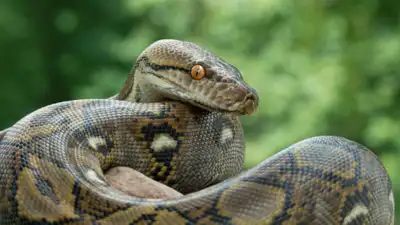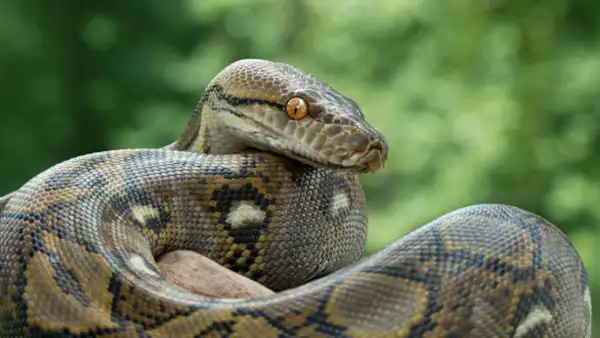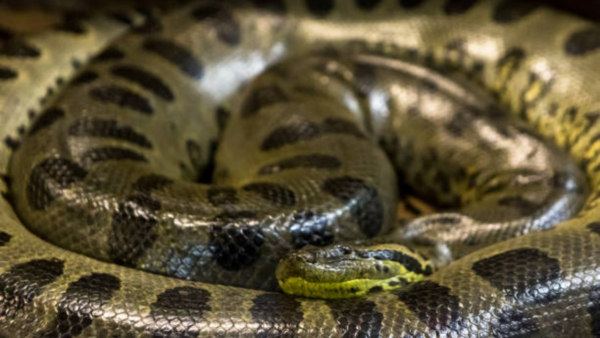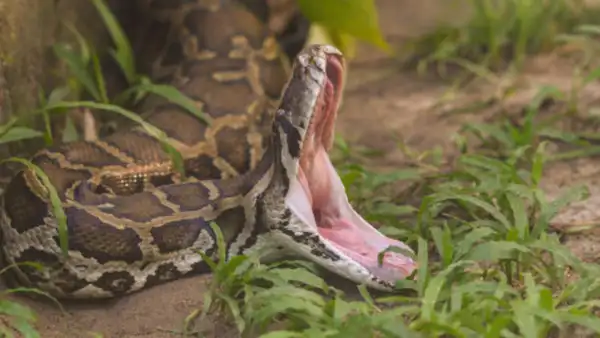ARTICLE AD BOX

Giant snakes, including reticulated pythons, green anacondas, Burmese pythons, and African rock pythons, are real predators capable of attacking humans. These powerful constrictors inhabit regions like Southeast Asia, the Amazon, and Florida, posing a threat due to their size and strength. While attacks are rare, they can be fatal, emphasizing the importance of caution and awareness in snake-prone areas.
When someone says “giant snake,” your brain probably jumps straight to a movie scene — you know, a huge slithery beast lurking in the jungle, ready to snatch a person like it’s grabbing a snack.
Sounds like fiction, right? Well... not always.The truth is, some snakes out there are big enough, strong enough, and occasionally bold enough to go after humans. It’s creepy. It’s fascinating. And yeah, it’s 100% real.
Why are we so obsessed with giant snakes?
Because they’re equal parts terrifying and amazing. These creatures are ancient, powerful, and totally alien in how they move and hunt. They’ve inspired myths and monsters for centuries, and it’s easy to see why.They’re real-life predators, living in wild places most of us never see — and that mystery only adds to their legend.
Reticulated Python
These guys are the world’s longest snakes. A reticulated python can stretch out over 20 feet, and a few big ones have even passed the 30-foot mark. That’s longer than a school bus!

They live in Southeast Asia — places like Indonesia, Thailand, and the Philippines. And here’s the kicker: they’re not just long, they’re strong.
These snakes don’t use venom. Instead, they wrap themselves around their prey and squeeze the life out of it. Literally. Once the prey stops moving? Gulp — in it goes, whole.And yes, humans have ended up on the menu. There have been actual cases where full-grown adults were found inside these pythons. Inside. Let that sink in.
Green Anaconda
If the reticulated python is the longest, the green anaconda is the heaviest. Found in the Amazon and swampy parts of South America, this beefy beast can weigh more than 500 pounds.
That’s like trying to wrestle a grand piano.

Anacondas spend a lot of time in water, where they sneak up on prey like caimans (mini-crocodiles), capybaras (giant rodents), and sometimes even jaguars. So yeah, humans? Not impossible.There are stories — still debated — of green anacondas attacking people. With the kind of strength and size they’ve got, it’s definitely within the realm of possibility. You do not want to go swimming where one of these monsters is chilling.
Burmese Python
Originally from Southeast Asia, Burmese pythons have made themselves way too comfortable in Florida’s Everglades. They’re an invasive species there now, causing all kinds of problems for local wildlife.

These snakes can grow over 20 feet long and weigh more than 200 pounds. They’re stealthy, powerful, and crazy good hunters.While attacks on humans are rare, they’ve happened. Especially with kids or smaller adults.
And in Florida, where people live close to the wild, close encounters aren’t all that unheard of.
African Rock Python
Over in Africa, this python reigns supreme. African rock pythons are massive (up to 20 feet long!) and have a rep for being aggressive. They don’t mess around.Unlike a lot of snakes that try to avoid humans, these ones are known for being bold. There have been multiple documented attacks — some fatal — in areas where people and snakes live close together.Basically, if it can fit in their mouth and they can squeeze it to death, it’s dinner.
Why would a snake even try to eat a human?
It’s not like snakes wake up craving people. But here’s why it happens:Size match: Big snakes can only eat prey they can fit in their mouths. So they’re looking for things about their width. Unfortunately, that can include children or smaller adults.These snakes are opportunistic. If the right moment presents itself — like someone alone, maybe asleep or distracted — they might go for it.We’re in their space! As people build homes or farms near forests, rivers, and swamps, snake encounters go up. And sometimes, nature bites back.
How do they even catch a human?
Usually, it’s a sneak attack. These snakes are masters of camouflage. They’ll lie in wait, completely still, until something (or someone) gets close. Then — strike! They bite, grab on, and wrap their bodies around the prey. Within seconds, it’s a deadly squeeze fest.Once the prey is still, they slowly start swallowing it whole, head first.
It’s not quick — but it's effective.Most of the time, they’ll go for people who are asleep, too small to fight back, or near water where the snake can ambush them.
Can they really kill people?
Yep. They absolutely can. And sadly, there are real, confirmed cases of people being killed — and even eaten — by giant snakes.Remember, they’re not venomous. It’s all muscle. Once they start squeezing, it cuts off blood flow and air. People can pass out in minutes.
If no one’s around to help, it can turn fatal quickly.
How to stay safe around giant snakes
If you live or travel in places where big snakes might be hanging around, here’s how to avoid becoming a snack:Don’t wander alone in the jungle or swampy areas — especially at night.Be careful near rivers and lakes where big snakes love to hide.Keep an eye on kids and pets in snake-prone areas.Watch for signs — like snake tracks, shed skin, or slither marks.If you see a huge snake, don’t play hero.
Back away. Slowly.In case of an attack — fight to create space. Yell. Get help fast.Giant snakes like the reticulated python, green anaconda, Burmese python, and African rock python aren’t just the stuff of nightmares — they’re very real. They’re rare, but deadly when things go wrong.So whether you’re trekking through the Amazon or flipping channels on Animal Planet, just remember: nature’s monsters don’t always need CGI. Sometimes, they’re out there… waiting in the tall grass.



.png)
.png)
.png)
















 4 hours ago
5
4 hours ago
5









 English (US) ·
English (US) ·